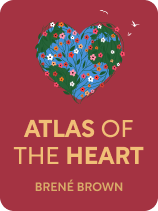

This article is an excerpt from the Shortform book guide to "Atlas of the Heart" by Brené Brown. Shortform has the world's best summaries and analyses of books you should be reading.
Like this article? Sign up for a free trial here .
Are you looking for Atlas of the Heart quotes by Brené Brown? What are some of the most noteworthy passages worth revisiting?
In her book Atlas of the Heart, Brené Brown—a popular public speaker, bestselling author, and professional social worker—provides a guide to the many emotions and mental states that people feel. Brown’s hope is that, with a deeper understanding of emotions, you’ll be able to talk about them more openly and accurately, and thus form deeper connections with the people around you.
Below is a selection of passages from Brené Brown’s book Atlas of the Heart: Mapping Meaningful Connection and the Language of Human Experience.
Atlas of the Heart: Mapping Meaningful Connection and the Language of Human Experience
Many people can only recognize and name three emotions: happiness, sadness, and anger. This lack of vocabulary blocks us from being able to fully experience and share our feelings with others—and that prevents us from forming connections with each other. In her book Atlas of the Heart, Brené Brown provides descriptions and explanations of 87 emotions, along with the situations where you’re likely to encounter them.
The following Atlas of the Heart quotes highlight some of the key ideas.
“But those who are able to distinguish between a range of various emotions “do much, much better at managing the ups and downs of ordinary existence than those who see everything in black and white.”
Many people can only recognize and name three emotions: happiness, sadness, and anger. This lack of vocabulary blocks us from being able to fully experience and share our feelings with others—and that prevents us from forming connections with each other. In Atlas of the Heart, Brown provides a guide to the many emotions and mental states that people feel. Brown’s hope is that, with a deeper understanding of emotions, you’ll be able to talk about them more openly and accurately, and thus form deeper connections with the people around you.
“For anxiety and dread, the threat is in the future. For fear, the threat is now—in the present.”
Brown defines anxiety as concern about the future. It is feeling like we’re not in control—we don’t know what’s going to happen, so we imagine the worst. For example, if you’re waiting for the results of a medical test, you might be anxious about what those results will show. Interestingly, excitement is nearly identical to anxiety, but we interpret the feelings in a positive way instead of a negative one. For example, one person might find gambling thrilling, while another can only imagine losing all of his or her money.
Whereas anxiety is concern about the unknown, fear is a response to a perceived threat in the present. Fear is a short-lived sensation that prepares us to deal with immediate danger using Fight, Flight, or Freeze responses.
“Empathy is not relating to an experience, it’s connecting to what someone is feeling about an experience.”
According to Brené Brown, empathy vs sympathy is an important distinction.
Brown says that empathy is the ability to understand and echo what someone else feels. However, note that empathy doesn’t mean imagining yourself in someone else’s place, or “walking a mile in his shoes,” as the old saying goes—trying to do so will cause you to bring your own biases and experiences to the situation. Rather, it means that you understand and accept the other person’s feelings, even if they might not be the same feelings you’d have in his place. Brown adds that compassion is empathy plus action: It’s the practice of relating to others and, as a result, acting to ease their suffering.
Brown says that sympathy is the near enemy of empathy. Just the opposite, in fact—sympathy draws a clear line between the person suffering and ourselves. In other words, sympathy is feeling bad for someone, but being unable (or unwilling) to relate to that person.

———End of Preview———
Like what you just read? Read the rest of the world's best book summary and analysis of Brené Brown's "Atlas of the Heart" at Shortform .
Here's what you'll find in our full Atlas of the Heart summary :
- Brené Brown's guide to the many emotions and mental states that people feel
- Explanations of 87 emotions, along with the situations where you’re likely to encounter them
- How to form deeper connections with the people around you






